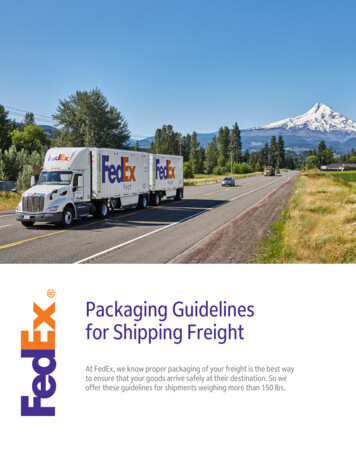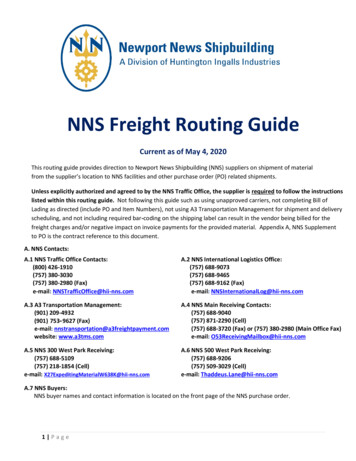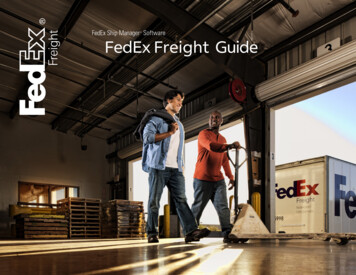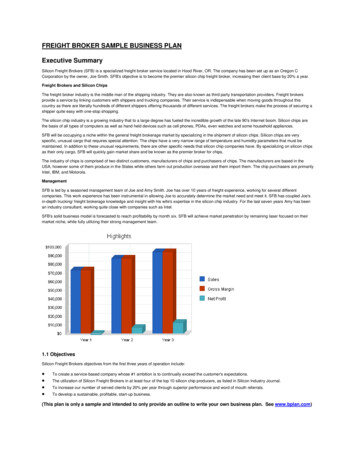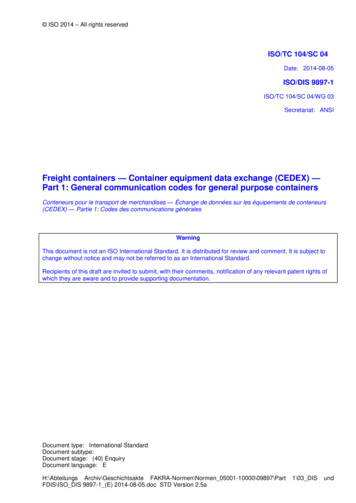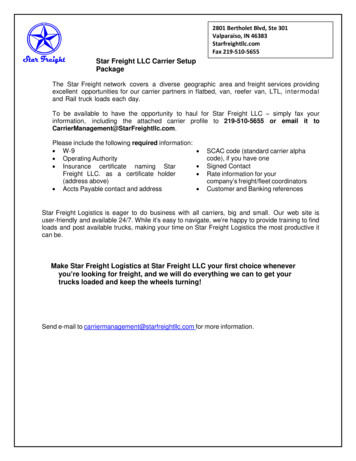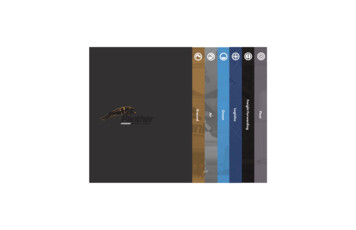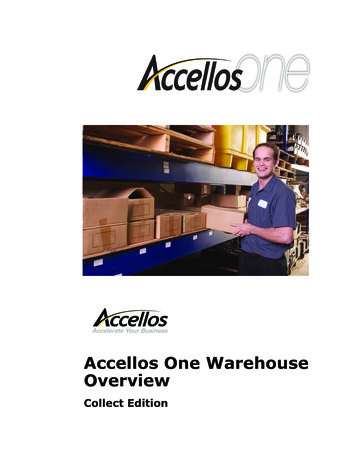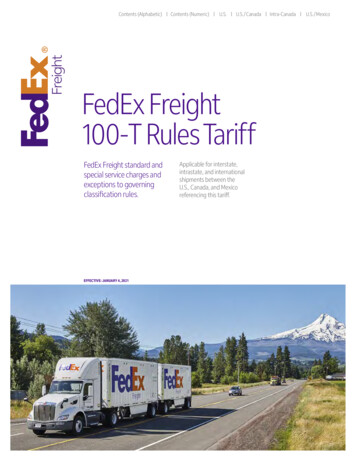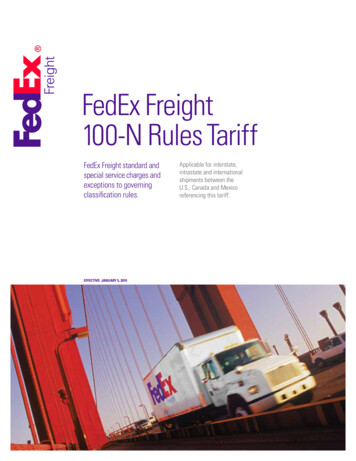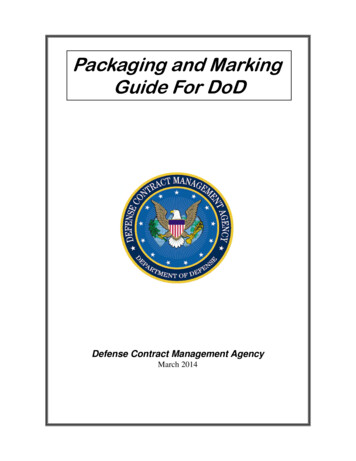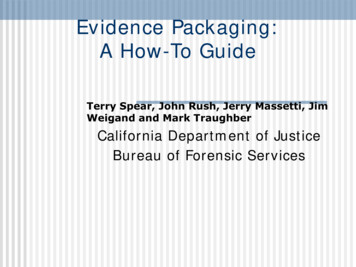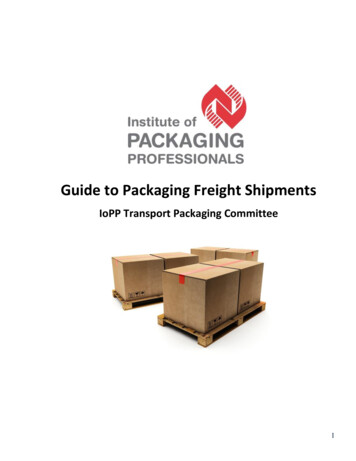
Transcription
Guide to Packaging Freight ShipmentsIoPP Transport Packaging Committee1
Guide to Packaging Freight Shipments(IoPP Transport Packaging Committee Final — 11/27/07 (updated 8/4/14))ScopeThese guidelines are voluntary and intended to assist in designing packages and othershipping units weighing 1 51 pounds or greater, that will perform satisfactorily as singleentities in a domestic or international freight carrier environment. These guidelines arenot to be considered approved carrier packaging specifications. Following part or all ofthese guidelines will not guarantee the automatic approval of a damage claim by anycarrier.TerminologyThe following terms are specific to this guide:Performance-based: Design criteria focused on achieving a satisfactoryperformance to specified elements, such as degree of hazard.Shipping Unit: The complete unit that will be subjected to the distributionenvironment, for example a crate, box, bag, pallet, or bundle capable ofmovement by mechanical handling equipment.Single Package: A single shipping container, including any interior protectivepackaging, which provides a means of protecting and handling a product.Freight Carriers: Distribution carriers that utilize air, ocean or land to transportshipments weighing over 1 50 pounds or shipments that are unitized or palletized.Freight Shipment: A shipment tendered to a freight carrierOversize Shipment: A shipping unit exceeding the carrier's size or weightrequirements.Transport Package: A shipping unit that provides containment and protection togoods during handling, storage, and transportation. The term includes allindustrial packaging and the shipping containers for consumer products.Significance and UseThis guide addresses the transportation environment, which includes manual handling andthe use of mechanical handling equipment.These guidelines will assist users in design and development of packaging intended forprotection of goods while they are in transit from point of origin through various freightsystems until reaching their final destination. The focus of this guide is shipmentsweighing more than 151 pounds.2
This guide includes domestic and international freight parcel shipments. Shipments ofregulated hazardous materials are excluded from this guide. If a hazardous substance isto be packaged for shipment, seek guidance from the in-house hazardous materialsspecialist or the carrier. Additional information is available at the Department ofTransportation website, http://hazmat,dot,gov, or phone 800-467-4922.This guide is not a set of detailed material specifications and design procedures. This guideis a listing of desired performance criteria for the transport package. Generally, thetransport package addressed by the guide will be secondary packaging, although for somegoods the transport package will be primary packaging. The following section on "TheShipping Environment" also applies to unpackaged products (tires, spools of wire,castings, etc.) since freight carriers transport many types of unpackaged goods.To facilitate development of proper packaging, users of this guide should be aware ofthe characteristics of package contents, including: Ability of the contents to withstand the effects of shock, compression andvibration during handling and transportation; Ability to support a load in compression Susceptibility to abrasion, moisture, corrosion, temperature, static electricityand magnetic fields.The Shipping EnvironmentThe normal shipping hazards found in the freight environment can vary by mode.Truckload, LTL, railcar, ocean and airfreight shipping environments typically includehazards that are unique to those modes as well as their common hazards, Many of themore severe hazards are due to the number of separate handlings required and themechanized material handling equipment used.Typical Carrier Systems: Most freight carriers rely on a "hub-and-spoke" network to coverlarge areas and offer fast, predictable transit times for shipments. The hub-and-spokesystem uses major sorting facilities, often called "hubs" or "depots", acting as exchangepoints for packages moving longdistances. Hubs are designed to sortthousands of packages an hour,permitting the quick exchange andredirection of freight.Each hub is connected to a numberof terminals or operating centers,which serve as home base for thelocal freight delivery vehicles andwhere the pickup and deliveryservice within specific geographicareas are provided. Operatingcenter boundaries are contiguousso that every address is covered. This system allows next-day ground service todestinations where such is possible, in this system, just because a shipment is3
designated as a freight package for "next-day air" does not necessarily mean it willtravel in an aircraft.Within each hub or operating center, the freight shipment may travel through the systemin a variety of ways, depending on the characteristics of the packaging and the equipmentand processes utilized by that particular facility. Shipments can be classified as eitherregular or irregular.Regular freight shipments are those that fall within the carrier's guidelines and are easilyhandled and transported without special care. RegularPackage designers should check their carrier todetermine the carrier's specific size and weight limits.Irregular shipments may be: Odd or unwieldy shaped shipments making them difficult to handle without damage Oversize with dimensions exceeding the carrier's standard limits Configured or labeled in such a way as to prohibit stacking A potential hazard to other shipments or personnel A shipment without any type of shipping containerDuring relatively short distance shipments (300 miles), some carriers may load/reloadpackages as many as five times and handle them using multiple methods includingmanually and mechanically, or automatic handling, Longer distances will likely result inmore loading, unloading, and sorting operations. These operations present a numberof hazards that could cause damage if the packaging does not provide adequateprotection.Transportation HazardsThere are many possible hazards in this environment, but the five principal onesare: shock; vibration; compression; extreme climate conditions; and altitude.Shock - will occur during handling when shipments are dropped, are struck by (or strike)other packages or objects during the sorting operation, or when they shift or fall duringtransit. The impacts create shock, which may cause fatigue or damage to the packagingand their contents. Recent studies of the handling environment of freight carriers haveshown that the majority of shocks result from non free-fall impacts and that most impactsare equivalent to drops from a relatively low height.Recent studies also indicate that impacts to shipments are mostly rotational drops onedges and somewhat less on corners. Few perfect flat or perfect edge/corner drops areencountered. Most impacts occur on the bottom surface, corners or edges of theshipments. From the package-engineering standpoint, packages should be designed towithstand shock from any direction. Due to the manual and mechanical handlingmethods, freight carriers may not guarantee orientation or shock labels, or "keep upright"4
arrows. Therefore, transit orientation may be different than the intended orientation.More likely, freight shipments will travel in the most stable orientation, usually thepackage's lowest center of gravity. This helps prevent freight packages from falling overduring the normal loading or sorting process.If irregulars are handled mechanically with forklift trucks, freight package impacts are mostoften the result of contact with the forklift, other freight shipments or the freightshipment falling from the forklift during handling. The dropdistance will depend on the height of the load beinghandled and the distance of the forklift blades from thesurface, distances typically ranging from 4 to 48 inches.(These types of drops do not occur as frequently as impacts)Other types of impacts that occur during forklift handlinginclude: impacts with pallets and other freight shipments;impacts with fork lift blades as freight packages bounceduring handling; and impacts as freight packages are loadedinto or unloaded from trailers, trucks, freight containers,racks or carts during sorting or transportation.Vibration- occurs when a freight package is mechanically moved or transported.Mechanical handling induces a low level of vibration into freight packages as the freightpackages bounce on the pallet or directly on the forklift blades during transit. Manualsorting induces virtually no notable vibration. Wide variations of transportationvibration may also occur in different rural and developed areas of the world, whichrequire special considerations or local data collection utilizing the latest vibrationmeasurement technology.In-transit motions subject freight packages to many levels of vibration over differentdurations of time. Aircraft and ocean going vessel vibration is typically low amplitudedepending on origin, destination, and the carrier's network. Truckload and trailer onflatbed railcar (TOFC, sometimes called piggyback) will subject the freight packages tomuch higher amplitudes than aircraft or ocean vessels. The duration can range from 5minutes to several days. Vibration can result in damage including scuffing, abrasion,loosening of fasteners and closures, freight package or freight product fatigue and failure.Compression- may be a static condition, as in a trailer, railcar, ocean container or aircraftwhen the freight package is under load from other freight packages and the vehicle is notmoving. Or it may be a dynamic condition, when the trailer, ocean container or aircraft isin motion. Dynamic compression will impose both vertical and lateral compressive forceswhen pressure is exerted onto the side of a freight package. This can occur when forklifthandling equipment is used to push loads into place inside a truck, trailer, rail car oraircraft container. When freight packages are pressed at mid-panel, the vertical sidepanels are more likely to bend or deflect. This deflection can cause internal EPS or otherrigid cushioning or molded pulp inserts to fail and cause harm to the content or it'saccessories. Ultimately, dynamic compression degrades the compression strength of theouter freight package container. In many instances stacking is unavoidable due to spaceand time constraints. Even with labels, such as "Do Not Stack" and "Top Load Only"warnings, special labels may not be guaranteed.5
Freight handlers may at times use an interlocking method rather than column stackingwhen loading freight shipments into trailers or aircraft containers, usually building a "wall"across the trailer or container. (Interlocking reduces corrugated box stacking strength upto 50%, compared to column stacking. However, interlocking patterns are more stable andbetter suited for random size shipments). Although the recommended practice is to loadlighter shipments on top of heavier shipments and smaller shipments on top of largershipments, there is no guarantee of this since freight packages arrive in a random fashionto the build-up or loading area and must be loaded as received.Freight handling and sorting operations contribute lower levels of compressive forcesthan in-transit movement. One exception to this is when freight shifts in-transit. This cancreate a large dynamic compressive force as heavier packages slide into, and accumulateagainst, other freight packages. Other instances of high compressive force can occurwhen pallets and forklifts are used to sort or load and unload freight packages. This isespecially true when freight packages overhang the pallet or are pushed into anotherpallet or against a vehicle or container wall. Compression damage can also occur whenpallet loads are stacked on top of each other. A loaded freight pallet with bottom deckboards will cause less damage to a load below it compared to a freight pallet with nobottom deck boards. A freight pallet with full bottom deck provides the best load support.Freight may also experience horizontal compression forces when clamp trucks are used inhandling and sorting operations. Multiple factors can affect the packaged-product beinghandled using a clamp truck. The more an object weighs, the greater the clamping forcerequired for clamping. The lower the coefficient of friction (COF) of the contact padsbeing used, the higher the clamping force required for clamping. Dynamic forces also actupon objects being handled by clamp truck and should also be taken into account.Climatic conditions- Environmental conditions which may cause damage due to effects oftemperatures and humidity. In most instances, carrier vehicles, as well as rail cars, are notconditioned. Therefore packages will be exposed to the same, or more extremetemperature and humidity inside the vehicle than exists outside. Freight packages may beexposed to temperatures as high as 140 F or as low as - 50 F inside the vehicle, andrelative humidity as high as 100%. The only exception is when a freight shipment is insidea temperature controlled trailer, ocean container, or aircraft. Large cargo aircraft arenormally conditioned to approximately 68 F to 74 F (refer to carrier for their specificaircraft temperature information).Altitude- Freight shipments may be exposed to altitudes as high as 20,000 feet in airshipments that travel in non-pressurized aircraft. Large cargo jets are pressurized toapproximately 8,000 feet. Over-the-road altitudes can vary as the shipments movethrough, across or over mountains. Domestic shipments in the USA typically do not exceedaltitudes of 12,000 feet.Other conditions- Several other conditions encountered in most freight shipment deliverysystems are different than those in other modes of transport. These include theorientation of packages when tilted on inclines and in flight, and the "bridging" of longpackages inside trailers or unit load devices. These conditions are also prevalent duringOcean vessel transportation.6
Loading and unloading of trailers and ocean containers may require forklifts to travel onincline ramps where package tilting can occur. Maintaining orientation is more difficultas the available space becomes limited. Pallet loaded freight shipments are normallykept upright but un-palletized freight shipments can be loaded in any orientation thatallows them to fit into the available space.In-transit inclines vary greatly between modes of transportation. Compared to trucks,aircraft are unique because they can move quickly and sharply in all three directions atthe same time. For example, the maximum operation angles for two common all-cargoaircraft are listed below:DC-8: 30-degree bank max, 10-degree descent max, 15-degree climb max.DC-10: 30-degree bank max, 10-degree descent max, 20-degree climb max.Ocean vessels may move in six different directions simultaneously (heave, yaw, pitch, roll,surge and sway). The severity and frequency of these motions is dependent on a numberof factors including the vessel size, weight, load configuration, and tide, weather or seaconditions. These forces in transit, in addition to load shifting and vibration, may causeshipments to move in virtually any orientation and angle.Bridging occurs when a long package is only supported near its ends. Damage can occur ifthe bridged package is struck near its center by another freight shipment, forklift, orother type of material handling equipment. In transit, long packages may be orientedsuch that they are not supported along their entire face (bridged), thereby incurring bothdynamic and static forces. Carrier Requirements/Restrictions: Each carrier has its own Terms and Conditions(T&C) that affect freight packaging; it is the shipper's responsibility to determine iftheir freight shipments meet those carrier's Terms and Conditions, Among therequirements or restrictions commonly listed are: Size Limits; Weight Limits;Perishables; Labeling; Special Commodity packaging instructions; Shipments requiringadvanced arrangements; Not Acceptable Items; Limitation of Liability; and MaximumDeclared Values. To find a carrier's Terms and Conditions go to the carrier's Tariff thatis posted on its website or published copies.General Design Recommendations (by freight package type)The following general design recommendations are presented in three categories offreight shipment package types: Type 1- factory packed, pre-engineered custom freight shipment packagedesign, dedicated to one productType 2- miscellaneous freight items packed in random order at fulfillmentcenters, catalog houses, and pick & pack consolidation operationsType 3- occasional freight packages prepared for miscellaneous itemsType 1- Factory packed in pre-engineered custom packages: To assure adequateprotection from shock and vibration, the freight package designer should determine the7
product's level of fragility. Fragility level identifies how much force is required to cause anunacceptable level of damage to the product. The most accurate way to do this is damageboundary (fragility) assessment using laboratory shock and vibration equipment, testing toASTM Test Methods D 3332 and D 3580. If that is not available, a reasonable estimateshould be made based on similar products or by working with the product designer todevelop an estimate.Generally, the product should be positioned in the center of the freight package systemunless either the fragility is known to differ by orientation, or it is critical to change thefreight package center of gravity. Style of corrugated or other appropriate shippingcontainer will depend largely on the method of packing to be used as well as shape andorientation of the packaged contents. Container strength and protective packagingwithin the container should be cost effective, consistent with product protection,packing labor, and any customer requirements.Freight products of higher value should be packaged using higher strength and level ofproduct protection than that used with moderate value products. Establishing abenchmark of percent cost of packaging to total product manufacturing cost will assist indetermining if packaging costs are equitable within a shipper's product line. However,other cost factors such as cost of failures, shipment returns, and assembly of packagedproducts, usability and transportation costs can far exceed the direct packaging costs.Customer preferences regarding package aesthetics, design features, and environmentalimpact may affect exterior and interior packaging choices, but must be balanced againstthe need to minimize costs, while providing the product with adequate protection.Type 2- Miscellaneous items packed in random order: In this situation, one or morefreight items are packed together as a single freight shipment. Many companies havesuccessfully developed packaging guidelines that define relative product fragility and theamount/thickness of protective packaging required. In the absence of these, a minimumof three to four (3-4) inches thickness of protective packaging or space separationbetween contents and container walls should be provided. The packager generallyconsiders product fragility during packing. Items deemed more fragile should have greaterclearance from container walls and more separation from other items inside thecontainer. The same rationale should be applied to products of higher than average value,i.e. products having much higher value than the shipper's average value for the samecubic volume should be packed in larger and stronger boxes or crates with additionalcushioning materials.If the freight-shipping container is a corrugated fiberboard box, use a style that is easilyfilled by the packer (usually an RSC style). Interior packaging materials should provideadequate protection based on the fragility of package contents and be of sufficientstrength to
The following terms are specific to this guide: Performance-based: Design criteria focused on achieving a satisfactory performance to specified elements, such as degree of hazard. Shipping Unit: The complete unit that will be subjected to the distribution
